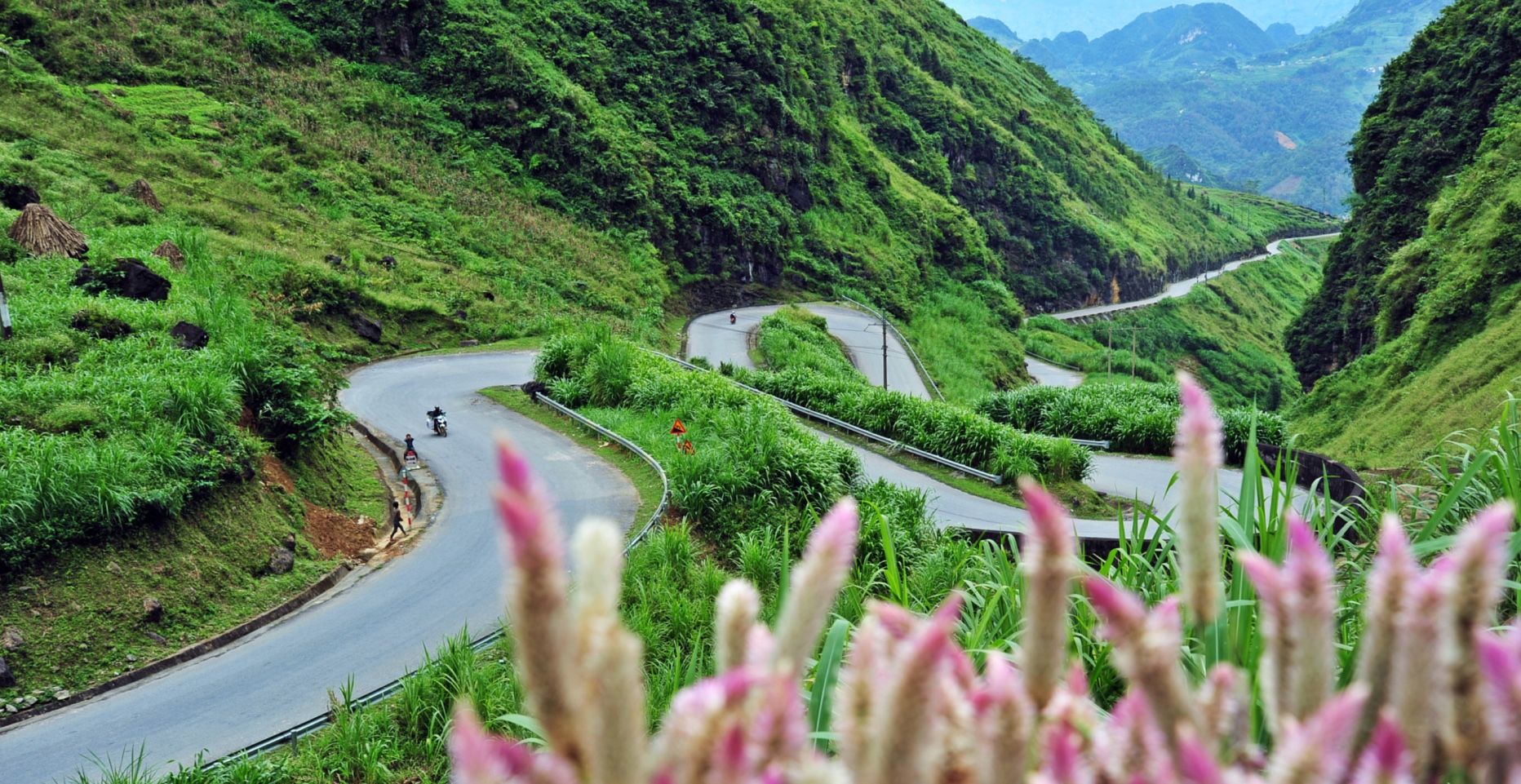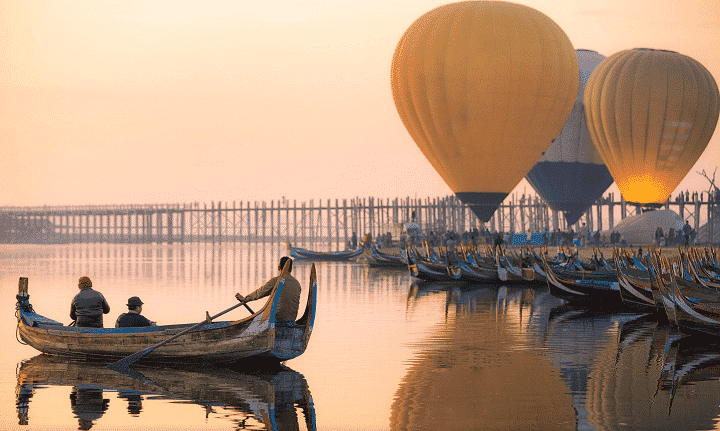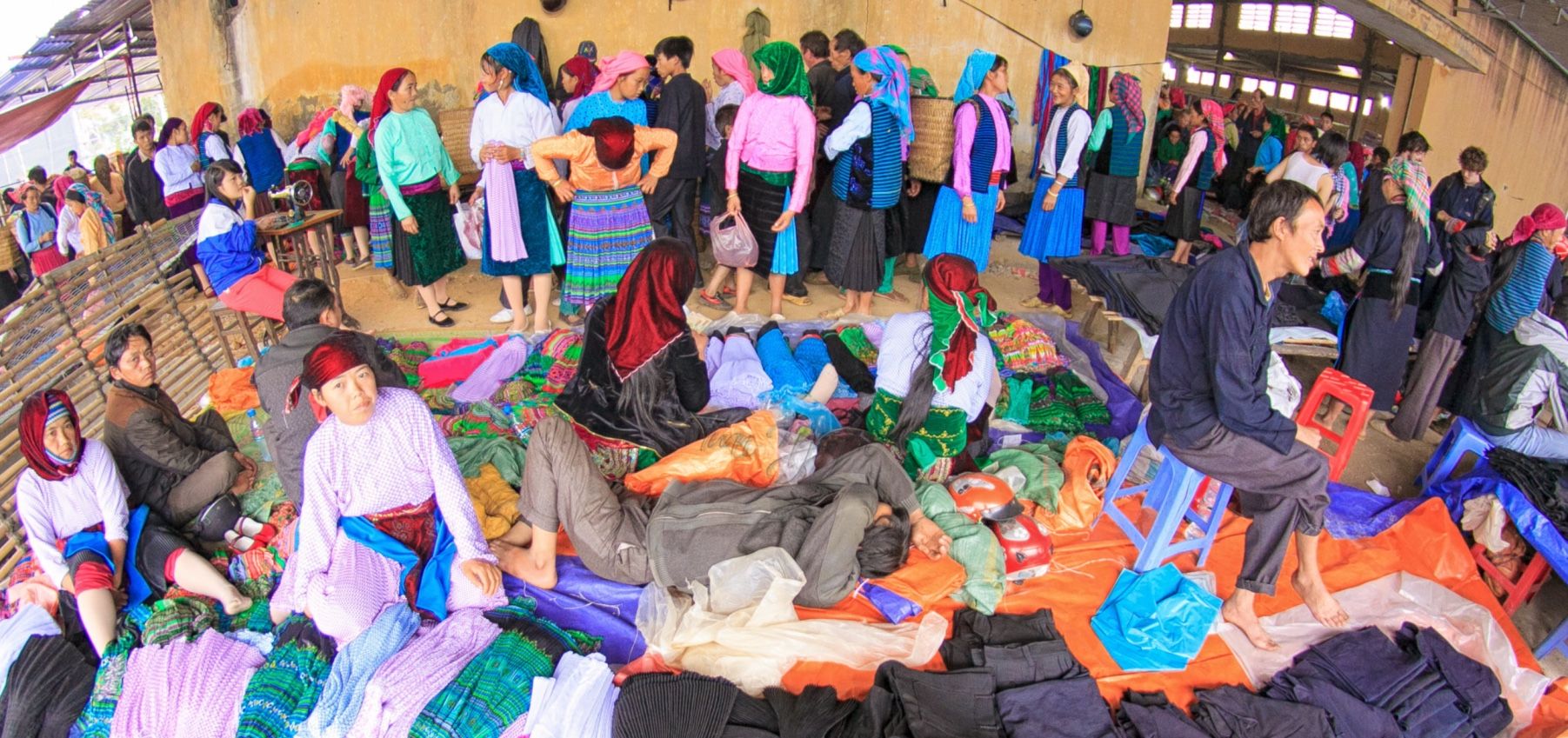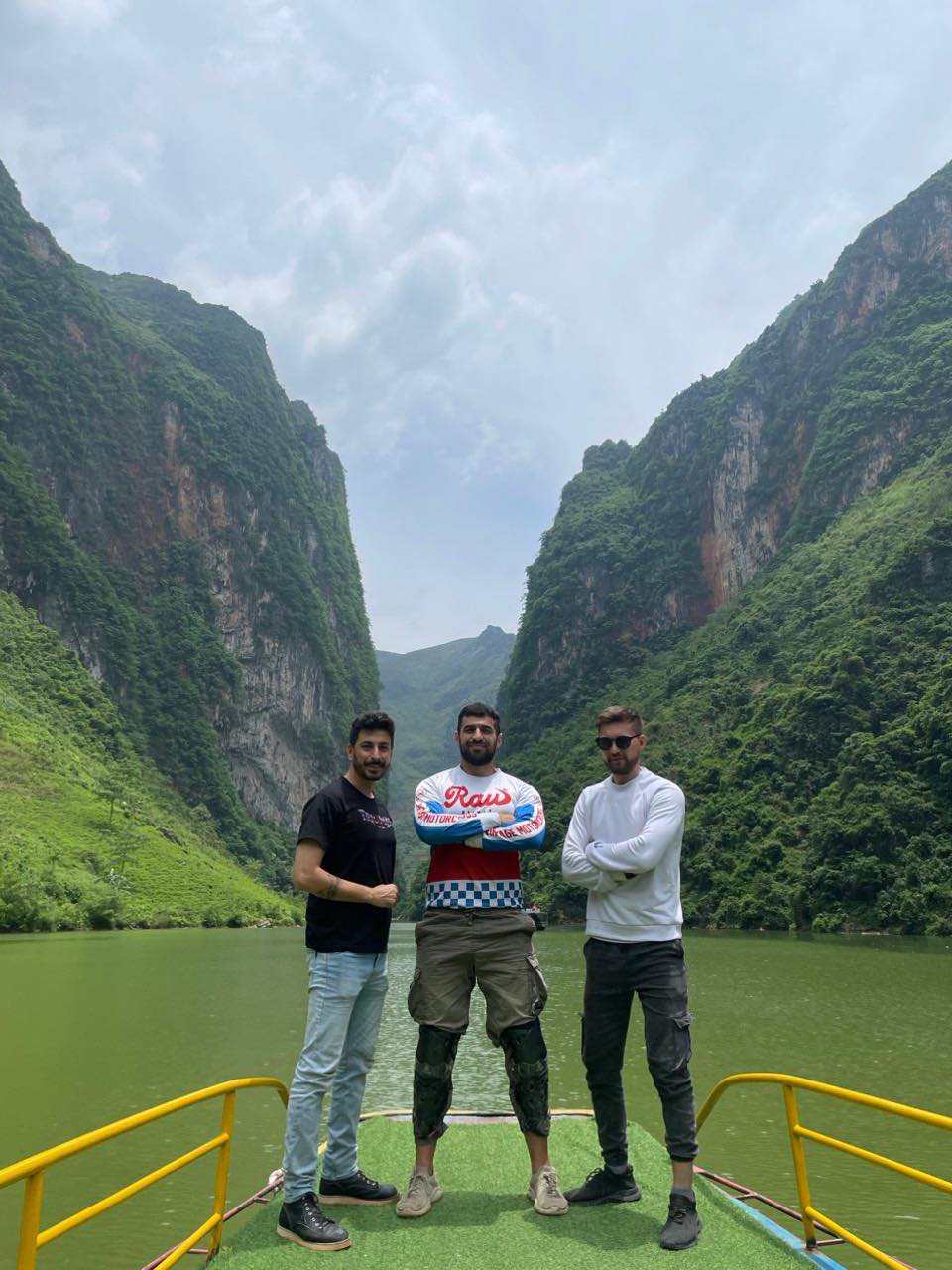HA GIANG LOOP
Explore the mesmerizing beauty on a Ha Giang Loop motorbike adventure tour, a journey through the stunning landscapes of Northern Vietnam. This exhilarating motorcycle adventure offers a unique blend of breathtaking scenery, rich cultural experiences of ethnic minorities, and thrilling winding roads.
Embark on over 380km loop through the picturesque Ha Giang province, surrounded by majestic limestone karsts and terraced rice fields in Vietnam. Discover the vibrant ethnic hill tribes, such as the Hmong and Dao, whose warm hospitality adds an authentic touch to your journey.
The Ha Giang Loop tour is simply an adventure that promises an unforgettable experience for all bikers, nature enthusiasts and thrill-seekers. Marvel at the breathtaking views from the Ma Pi Leng Pass, known as the “King of Passes,” offering panoramic vistas of the Nho Que River winding through the deep valley below.
Ha Giang loop motorbike tour invites you to immerse yourself in the charm of traditional villages and local markets, capturing the essence of Vietnam’s diverse culture. Whether you’re a solo traveler or seeking a group adventure, the Ha Giang Loop guarantees a worthy experience and memories to last a lifetime. Discover the allure of this hidden gem as you navigate the winding roads and embrace the untouched beauty of Ha Giang.
Where Exactly is Ha Giang Loop – How Many Kilometers does it cover?
Ha Giang Loop is the name that motorbike riders put on where the actual Ha Giang Province is when looking at through the google map. Different adventurer & motorbike riders choose different route, however, the most chosen route is the Ha Giang all the way to Đồng Văn and Mèo Vạc. The Ha Giang Loop is best managed by motorbike, and when I say motorbike, I meant, the higher the displacement is, the better. Yes, I know so many young backpackers sit on behind a 110cc motorbikes driving by a Vietnamese rider and they also call this “Ha Giang Loop”. All works the same, but I am here talking about the joy and performance you can get when riding a +600CC motorbike.
However, some travelers opt for a public transport since the transport quality is well improved now as that years of roadworks are largely completed. You’ll still need to arrange private transport to reach off-the-beaten-track attractions like Lung Cu and the Vuong Palace though and what better way to do all this loop on a motorbike.
Ha giang loop is Vietnam’s premier adventure go and the whole region is somewhere to recharge the batteries on the long road north. The scenery is a good taste of things to come, with limestone outcrops soaring skywards over the town. Those heading further north to explore the districts of Yen Minh, Dong Van, Meo Van and Bac Me prepare for an ultimate road trips with high adrenaline of at least 3 days loop touring.
Ha Giang loop 3 – 5 day route itinerary
Here is the full Ha Giang Loop from Ha Giang town, for following route, you’ll need at least 3 full days. And, if you start to ride from Hanoi, you’ll need 5 days to do the full loop.
Hà Giang → Tam Sơn, or Quản Bạ
Tam Sơn → Yên Minh
Yên Minh → Lũng Cú [Flagpole]
Lũng Cú → Đồng Văn
Đồng Văn → Mèo Vạc
Mèo Vạc → Mậu Duệ/Bảo Lạc
Mậu Duệ → Du Gìa
Du Gìa → Hà Giang
5 Day Ha Giang loop itinerary
The Ha Giang Loop is a stunning motorbike journey through the mountainous region of Ha Giang in northern Vietnam. It typically takes 3 to 5 days to complete, depending on how much time you want to spend exploring and taking in the breathtaking landscapes. Here’s a suggested itinerary for a 3 to 5 day Ha Giang Loop:
Day 1: Ha Giang City to Quan Ba (via Tam Son)
- Start your journey in Ha Giang City.
- Head towards Quan Ba, passing through Tam Son and the stunning Quan Ba Twin Mountains.
- Explore the Lung Tam Linen Village and the local markets.
- Stay overnight in Quan Ba.
Day 2: Quan Ba to Yen Minh (via Dong Van)
- Ride to Dong Van via the famous Heaven’s Gate Pass.
- Visit the Dong Van Old Quarter.
- Continue to Yen Minh, passing through the Ma Pi Leng Pass, one of the most beautiful mountain passes in Vietnam.
- Stay overnight in Yen Minh.
Day 3: Yen Minh to Meo Vac
- Explore the Vuong Palace in Dong Van.
- Ride to Meo Vac through the stunning landscapes.
- Visit the Meo Vac Market and experience the local culture.
- Stay overnight in Meo Vac.
Day 4: Meo Vac to Du Gia (via Lung Cu)
- Head towards Lung Cu, the northernmost point of Vietnam.
- Visit the Lung Cu Flag Tower.
- Continue to Du Gia, a less-visited but charming village.
- Stay overnight in Du Gia.
Day 5: Du Gia to Ha Giang City
- Enjoy the scenic ride back to Ha Giang City.
- Optionally, explore any spots you may have missed on the way.
- Return to Ha Giang City to conclude your journey.
Remember that road conditions may vary, and weather can be unpredictable, so plan accordingly. Additionally, make sure your motorbike is in good condition, and you have the necessary skills for the Ha Giang loop and specially the remote areas. Always check for the latest travel information and consider hiring a local guide if you’re not familiar with the area.

How Many Days for a perfect Ha Giang Loop Adventure?
The duration of an adventure along the Ha Giang Loop in northern Vietnam can vary depending on several factors, including the route taken, mode of transportation, and the number of stops you make along the way. The Ha Giang Loop typically covers a distance of around 300 to 400 kilometers (186 to 248 miles), and the road conditions can vary.
Bikers with experience riding motorbike, which is the most common mode of transportation for this adventure, the loop can take anywhere from 2 to 4 days to complete. This allows for a leisurely pace too, giving you time to explore the stunning landscapes, interact with local communities, and enjoy the experience. Keep in mind that the roads in the Ha Giang and up north can be challenging too, with winding mountainous terrain, so your speed of travel may be slower than on well-maintained highways.
If you’re short on time, but still want to experience the famous Ha Giang loop, it’s technically possible to do it in a day or two, but you’ll miss out on the opportunity to fully appreciate the beauty of the region and engage with the local culture. Many travelers recommend taking at least 3-4 days to truly enjoy the journey and immerse yourself in the unique atmosphere of Ha Giang.
Always check the current road conditions, weather forecast, and your own comfort level with long rides before embarking on such an adventure. Additionally, be sure to adhere to local traffic regulations and safety precautions.
Ha Giang to Yen Minh → 100 KM (3 hours driving)
Yen Minh to Dong Van → 50 KM (1.5 hours driving)
Dong Van to Meo Vac → 30 KM (1 hour driving)
Meo Vac to Du Gia → 70 KM (3 hours driving)
Du Gia to Ha Giang → 70 KM(2.5 hours driving) in 2024, with gravel road conditions, muddy high mountain roads on rainy days.

What is the best time to take a Ha Giang Loop Vietnam?
The best time to go for an adventure and explore the Ha Giang Loop in Vietnam is during the dry season, which typically runs from September to November. During this time, the weather is more stable, and you can enjoy clear skies and pleasant temperatures. The landscapes are lush and green after the rainy season, making it an ideal time for motorbike trips and trekking.
Avoid the rainy season, which usually occurs from June to August, as the roads can be slippery and challenging to navigate. Additionally, winter (December to February) can be quite cold, with some areas experiencing temperatures close to freezing, especially at higher elevations. The spring months of March and April can also be a good time to visit, but keep in mind that weather conditions can be less predictable during this transitional period.
Avoid the rainy season, which usually occurs from June to August, as the roads can be slippery and challenging to navigate. Additionally, winter (December to February) can be quite cold, with some areas experiencing temperatures close to freezing, especially at higher elevations. The spring months of March and April can also be a good time to visit, but keep in mind that weather conditions can be less predictable during this transitional period.
Ultimately, plan your Ha Giang loop based on your preferences and the type of activities you want to engage in. If you’re interested in vibrant landscapes and comfortable weather, the dry season is your best bet. Check out → Best Time To Visit Vietnam
What to See in Ha Giang Loop: 10 Highlights of the Road Trip
- Dong Van Karst Plateau Geopark:
- Explore the rugged beauty of this UNESCO Global Geopark, known for its limestone karst formations and diverse ecosystems.
- Ma Pi Leng Pass:
- Drive through one of the most breathtaking mountain passes in Vietnam, offering panoramic views of the Nho Que River and surrounding landscapes.
- Hmong King’s Palace (Vuong Chi Sinh Palace):
- Visit the former residence of the Hmong king, showcasing a blend of French and Chinese architectural styles.
- Lung Cu Flag Tower:
- Reach the northernmost point of Vietnam, where you can see the giant Vietnamese flag and enjoy panoramic views of the border with China.
- Quan Ba Heaven’s Gate:
- Admire the stunning landscapes of the Twin Mountains and the “Fairy Bosom” valley, known for its picturesque beauty.
- Meo Vac Market:
- Experience the vibrant local culture by visiting the Meo Vac Market, where various ethnic groups gather to trade goods and socialize.
- Tham Ma Slope:
- Drive through this scenic and challenging mountain pass, surrounded by lush greenery and winding roads.
- Hoang Su Phi Terraced Rice Fields:
- Marvel at the terraced rice fields that change colors with the seasons, creating a spectacular mosaic on the mountainsides.
- Ha Giang City:
- Explore the provincial capital, Ha Giang City, to experience the local way of life, sample regional cuisine, and visit historical sites.
- Yen Minh Pine Forest:
- Enjoy the tranquility of Yen Minh Pine Forest, where you can take a leisurely walk or simply relax amidst the tall pine trees.
Remember that the Ha Giang Loop is a remote and challenging route, so make sure to plan your journey carefully, taking into account road conditions, weather, and your mode of transportation. Additionally, respecting the local culture and customs is essential for a meaningful and enjoyable experience.
Ha Giang Loop Motorbike riding packing items
When planing a motorcycle adventure on the Ha Giang Loop in Vietnam, it’s crucial to pack efficiently, especially considering the varied weather conditions and the adventurous nature of motorcycle riding. Here’s a suggested packing list for motorcycle riding gear and luggage:
Motorcycle Riding Gear:
- Helmet: Ensure it meets safety standards and provides full protection.
- Jacket and Pants: Invest in a durable, weather-resistant motorcycle jacket and pants with padding for safety.
- Gloves: Full-fingered, weather-resistant gloves to protect your hands.
- Boots: Sturdy, ankle-high boots with good grip for both riding and walking.
- Rain Gear: Waterproof jacket and pants to stay dry during unexpected rain.
- Buff/Scarf: Protect your face from dust, wind, and cold.
- Armor: Consider additional armor for chest, back, and knees for extra protection.
Clothing:
- Base Layers: Lightweight and moisture-wicking for both warm and cool weather.
- Riding Gear Off the Bike: Comfortable clothing for off-bike activities.
- Swimsuit: If you plan to take a dip in natural springs or waterfalls.
- Quick-Dry Towel: Compact and dries quickly for your convenience.
- Hat or Cap: Protect yourself from the sun.
Accessories:
- Sunglasses: Polarized sunglasses to reduce glare.
- Sunscreen: High SPF to protect your skin.
- Bug Repellent: Especially important if you’re camping or staying in rural areas.
- Camera/GoPro: Capture the stunning landscapes.
- Power Bank: Keep your devices charged.
- Navigation: Map (Google map works fine), or a reliable smartphone app for navigation.
Luggage:
- Waterproof Bags: Keep your clothes and electronics dry, especially if you encounter rain.
- Tank Bag or Backpack: Convenient for quick access to essentials.
- Packing Cubes: Organize your clothes and maximize space.
- Bungee Cords/Net: Securely strap down your luggage on the bike.
- Small Locks: Secure your bags when needed.
- Tool Kit: Basic tools for motorcycle maintenance.
Documents and Essentials:
- Passport and valid Visa: Carry necessary identification and travel documents.
- International Driving Permit: You’ll required to have a valid driving license, or international equivalent of that.
- Motorcycle Papers: Known as Blue card, carry it with you in case the road traffic stop to check. Ensure you have all required documents for the motorcycle.
- Emergency Information: Emergency contacts, medical information, and insurance details.
Remember to adapt this list based on your personal needs and the duration of your trip. Check the weather forecast before you go and be prepared for different weather conditions. Stay safe and enjoy the Ha Giang Loop!
What to eat on Ha Giang loop adventure
There is nothing that fancy once you drive out of Ha Giang town. Even in Ha Giang, there is few places from where you can find western food such as pizza or similars. It sounds like the dining experience in Ha Giang loop is a truly authentic and local one, providing visitors with a genuine taste of the north Vietnam’s culture. The emphasis on homestays for meals adds a personal touch, allowing travelers to engage with local families and other guests. The simplicity of the food, such as noodles or banh mi for breakfast, reflects the local culinary preferences.
The communal aspect of dinner, where guests dine together with the family at their homestay, fosters a sense of community and offers a unique opportunity for cultural exchange. Sharing a meal with locals can be a rich experience, providing insights into their daily lives, traditions, and perhaps even language.
The mention of local rice wine, often referred to as “happy water,” adds an extra layer to engage with local culture. It’s not just about the food; it’s about the social rituals and connections that come with sharing a drink and engaging in conversation. This type of dining experience is appreciated by travelers seeking a more authentic and off-the-beaten-path adventure, embracing the local way of life rather than seeking familiar Western comforts.
Copyright 2013-2017 Vietnamese Private Tours Ltd With Vietnam Luxury Travel







